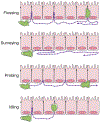γδ T cell migration: Separating trafficking from surveillance behaviors at barrier surfaces
- PMID: 32845516
- PMCID: PMC7968450
- DOI: 10.1111/imr.12915
γδ T cell migration: Separating trafficking from surveillance behaviors at barrier surfaces
Abstract
γδ T cells are found in highest numbers at barrier surfaces throughout the body, including the skin, intestine, lung, gingiva, and uterus. Under homeostatic conditions, γδ T cells provide immune surveillance of the epidermis, intestinal, and oral mucosa, whereas the presence of pathogenic microorganisms in the dermis or lungs elicits a robust γδ17 response to clear the infection. Although T cell migration is most frequently defined in the context of trafficking, analysis of specific migratory behaviors of lymphocytes within the tissue microenvironment can provide valuable insight into their function. Intravital imaging and computational analyses have been used to define "search" behavior associated with conventional αβ T cells; however, based on the known role of γδ T cells as immune sentinels at barrier surfaces and their TCR-independent functions, we put forth the need to classify distinct migratory patterns that reflect the surveillance capacity of these unconventional lymphocytes. This review will focus on how γδ T cells traffic to various barrier surfaces and how recent investigation into their migratory behavior has provided unique insight into the contribution of γδ T cells to barrier immunity.
Keywords: immune surveillance; migration; mucosal immunity; γδ T cells.
© 2020 John Wiley & Sons A/S. Published by John Wiley & Sons Ltd.
Figures


References
-
- Carding SR, Egan PJ. Gammadelta T cells: functional plasticity and heterogeneity. Nat Rev Immunol. 2002;2(5):336–345. - PubMed
-
- Hayday AC. gammadelta T Cell Update: Adaptate Orchestrators of Immune Surveillance. J Immunol. 2019;203(2):311–320. - PubMed
-
- Hayday AC, Vantourout P. The Innate Biologies of Adaptive Antigen Receptors. Annu Rev Immunol. 2020;38:487–510. - PubMed
Publication types
MeSH terms
Substances
Grants and funding
LinkOut - more resources
Full Text Sources

